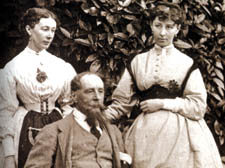 Katey, right, with sister Mamie photographed with Charles Dickens in 1865 Katey, right, with sister Mamie photographed with Charles Dickens in 1865 |
The dutiful daughter of our greatest writer
Charles Dickens’s daughter Katey fought to establish herself as an
artist in her own right, says
Illtyd Harrington
Katey – The Life and Loves of
Dickens’s Artist Daughter
by Lucinda Hawksley.
Doubleday. £20. order this book
SHE was the third child of ten, the second daughter of England’s greatest novelist and social campaigner Charles Dickens. Katey was born in 1839 in 48 Doughty Street, Bloomsbury, and lived until 1929 when she died in Chelsea, a commanding figure in London society.
Here she is remembered by Charles Dickens’s great-great-great-granddaughter Lucinda Hawksley who draws a portrait of a member of a family some of whom inherited the feckless spendthrift characteristics of Dickens’s father – the model for Mr Micawber in David Copperfield.
Their father led life at a furious pace and it was a strenuous effort to keep up with him and the boundless energy he poured into fiction and fact.
Katey seems to have the lion’s share of the staying power. She became a favourite of the fashionable portrait painter Millais and he captured her beauty in several pictures. A pioneer of the Pre-Raphaelite Brotherhood, he drew Dickens’s fire but became Katey’s life-long friend.
At 13, she began studying drawing at Bedford College, the first women’s college, and eventually specialised in portraiture. Dickens’s frenetic energy brought his children into his love of home theatre where she helped to build and paint scenery as well as act in a succession of homes, Doughty Street, Osnaburgh Street or Tavistock Square. Katey later became close to the novelists Thackeray, Wilkie Collins and J M Barrie.
Dickens’s wealth bought Gad’s Hill in Kent, near Rochester, and family activity became even more intense.
In 1858 she met Wilkie Collins’s brother Charlie and eventually married the struggling artist. She continued to model with Millais but Charlie’s protracted illnesses and impecuniousness did not curb the strong-minded woman. The marriage was never consummated. Draw your own conclusions.
Charlie was endlessly ill. Meanwhile Dickens had begun an affair with an 18-year-old Ellen Ternan. His wife Catherine eventually left home to live near Regent’s Park. Oddly enough there was no outbreak of Victorian morality as Dickens openly walked with his young lover on Hampstead Heath.
This caused a domestic upheaval which divided the family. No more happy families with mother banished.
Katey met and flirted at least with the artist Valentine Prinsep but Charlie Wilkie took an inconsiderable time dying and Kate stayed loyal.
Her father never showed much enthusiasm for her works of art but exhausted, he died in 1870.
Katey’s acting ambitions had been discouraged by her father but stimulated by George Bernard Shaw. They engaged in forceful correspondence. A competent woman, she seemed to have a fair measure of the Victorian inner strength and sure-footed confidence. Charlie eventually died in 1873 and she married Carlo Peruguni, another artist in 1874. A baby son, Dickie, sadly died at six months.
Carlo died in 1918 and Katey in 1929.
Katey could be perverse and strong willed but her passionate nature and fierce loyalties to her separated parents, siblings and friends builds up to an intriguing insight into the dysfunctional Dickens family. Some dropped dead, others were weighed down with mounting debts. Not all could live up to their iconic father.
In great old age she knew how to manipulate her father’s powerful public morality and brush aside his cruel adultery. London society beat a path to her door.
Katey’s tale and longevity is a rushing and sudden wind which carefully does not blow out the emotional power of the Yule candles in The Christmas Carol and ring-fences the Dickensian legend that good always triumphs over bad.
|
 Katey, right, with sister Mamie photographed with Charles Dickens in 1865
Katey, right, with sister Mamie photographed with Charles Dickens in 1865
